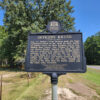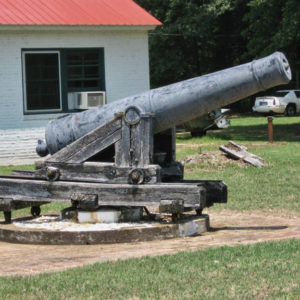calsfoundation@cals.org
St. Charles Battle Monument
The St. Charles Battle Monument, located in the center of the intersection of Arkansas Street and Broadway in St. Charles (Arkansas County), is a commemorative monument erected in 1919 in honor of the casualties of the 1862 engagement at St. Charles.
On June 17, 1862, a Union flotilla steamed up the White River to bring supplies to Major General Samuel R. Curtis’s Army of the Southwest, which was threatening Little Rock (Pulaski County) from eastern Arkansas. Confederate troops had sunk the gunboat CSS Maurepas and a pair of steamboats at St. Charles to block the river and placed cannon on shore to bombard any approaching vessels. The USS Mound City led the Union force. Around 10:00 a.m., a Confederate shell entered the gunboat and struck its steam drum, releasing scalding steam that killed many sailors. Others jumped overboard, where many were shot by Confederate snipers—150 of the 175-man crew were killed or injured. Soldiers of the Forty-Sixth Indiana Infantry Regiment were set ashore and soon overran the Confederate defenders, but the flotilla ultimately failed to link with Curtis, who marched his army across eastern Arkansas to seize Helena (Phillips County), making the Mississippi River town a Union base for the rest of the war.
Among the Union casualties was William Hickman Harte, an Irishman serving as second master of the Mound City. A Union sailor who was rescuing men from the Mound City wrote that “Second Master W. H. Harte came floating by, and I pushed off the boat to pick up him, and Mr. Kinzie, who was also near him in the water. The latter I saved, but Mr. H. went down.”
There are two accounts of how the St. Charles Battle Monument came to be. One says that “a son of William Hickman Harte…came here searching for the grave of his father” and that a local judge who had aided the wounded sailor took him to the grave. “The son later had this splendid monument erected in loving memory of his father, and in memory of the Confederate and Federal dead who lost their lives here.” Another source claims that one of Harte’s nephews placed the monument in St. Charles. Given the first-person account of Harte’s drowning and the fact that the late sailor is buried beneath an elaborate gravestone at Chippiannock Cemetery in Rock Island, Illinois, both accounts seem to be inaccurate, though Harte did have a son, a Philadelphia surgeon who likely placed the monument. It was dedicated on April 26, 1919.
The St. Charles Battle Monument is a large, square granite monolith topped with an inverted cannon barrel. Its southeast face features a shield emblazoned with a deer and the motto “COURE FIDELE” above the inscription “IN LOVING MEMORY OF / WILLIAM HICKMAN HARTE / MASTER, U.S.N. / BORN LIMERICK IRELAND, 1826 / KILLED IN ACTION JUNE 17, 1862.” The northeast face is inscribed “OFFICERS AND MEN KILLED ON / THE U.S.S. MOUND CITY,” followed by a list of 124 names. The northwest face is inscribed “NEAR THIS SPOT, ON JUNE 17, 1862 / A DECISIVE BATTLE WAS / FOUGHT HERE BETWEEN THE CONF- / -EDERATES ENTRENCHED AND / THE FEDERAL GUNBOATS. / HERE WAS FIRED THE MOST DESTRUCTIVE SINGLE SHOT / OF THE CIVIL WAR, CAUSING AN / EXPLOSION ON THE “MOUND CITY” AND THE LOSS OF 148 / KILLED, BESIDES MANY WOUNDED. /O, WHERESOEVER THESE MAY BE / BETWIXT THE SLUMBER OF / THE POLES, TO-DAY THEY / COUNT AS KINDRED SOULS.” The southwest face of the monument has the inscription “CONFEDERATE SOLDIERS / KILLED IN THE BATTLE / OF ST. CHARLES / COMPANY G. 29TH. ARKANSAS INFANTRY. / JUNE 17, 1862. / W. G. YARBROUGH / W. C. KLINGLE / J. P. HALL.”
A United Daughters of the Confederacy publication describes the St. Charles Battle Monument as “unusual in Arkansas in that it is one of two monuments in the state located in the middle of a highway [the other is the Lake Village Confederate Monument]….It is unusual, perhaps unique, in the South, in that it was erected by a Northern man and commemorates the men of both sides of the encounter.” The monument was listed on the National Register of Historic Places on May 3, 1996.
For additional information:
Dodson, Mrs. Thomas F. “Confederate Monuments and Markers in Arkansas,” Arkansas Division UDC, 1960.
Henderson, J. M., Jr. Brief Stories of St. Charles in Romance and Tragedy. DeWitt, AR: n.d.
Milligan, John D., ed. From the Fresh-Water Navy: 1861-64, The Letters of Acting Master’s Mate Henry R. Browne and Acting Ensign Symmes E. Browne. Annapolis, MD: United States Naval Institute, 1970.
Rhodes, Sonny. “Small Town, Big History.” Arkansas Democrat-Gazette, February 6, 2023, pp. 1D, 6D. Online at https://www.arkansasonline.com/news/2023/feb/06/st-charles-little-arkansas-town-with-big-civil/ (accessed February 6, 2023).
Slater, John. “St. Charles Battle Monument.” National Register of Historic Places registration form. On file at Arkansas Historic Preservation Program, Little Rock, Arkansas. Online at https://www.arkansasheritage.com/arkansas-historic-preservation-program (accessed February 6, 2023).
Mark K. Christ
Arkansas Historic Preservation Program
 Civil War Markers and Memorials
Civil War Markers and Memorials Early Twentieth Century, 1901 through 1940
Early Twentieth Century, 1901 through 1940 Historic Preservation
Historic Preservation Engagement at St. Charles Cannon
Engagement at St. Charles Cannon  St. Charles Battle Monument
St. Charles Battle Monument 




The St. Charles Battle Monument is one of my earliest memories. I walked past it every day on my way to school in 1953.